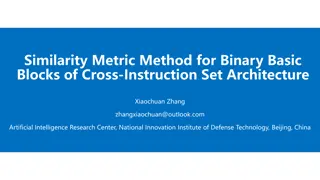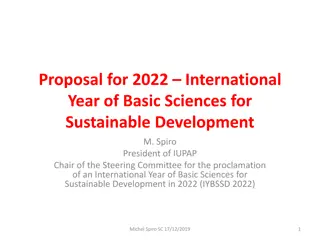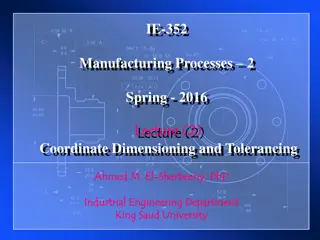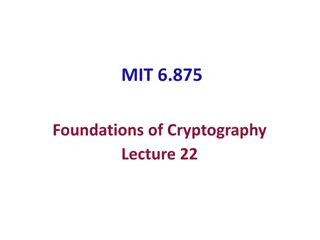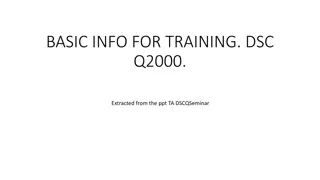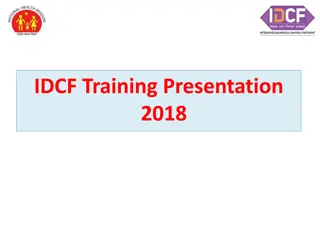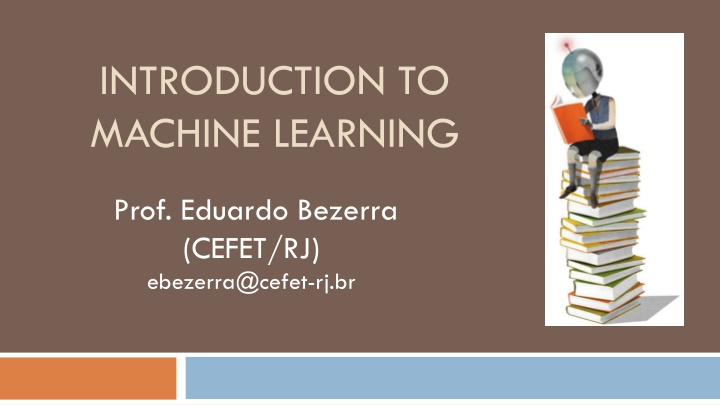
Machine Learning Concepts
Dive into the world of machine learning with basic concepts, definitions, and comparisons with traditional programming. Explore the origins of machine learning and its various tribes. Learn about key terminologies and families of machine learning tasks. Discover how computers can learn from experience and improve performance over time.
Download Presentation

Please find below an Image/Link to download the presentation.
The content on the website is provided AS IS for your information and personal use only. It may not be sold, licensed, or shared on other websites without obtaining consent from the author. If you encounter any issues during the download, it is possible that the publisher has removed the file from their server.
You are allowed to download the files provided on this website for personal or commercial use, subject to the condition that they are used lawfully. All files are the property of their respective owners.
The content on the website is provided AS IS for your information and personal use only. It may not be sold, licensed, or shared on other websites without obtaining consent from the author.
E N D
Presentation Transcript
INTRODUCTION TO MACHINE LEARNING Prof. Eduardo Bezerra (CEFET/RJ) ebezerra@cefet-rj.br
Machine Learning (to play Checkers) 3 Coined the term Machine Learning ( Field of study that gives computers the ability to learn without being explicitly programmed. ) it will learn to play a better game of checkers than can be played by the person who wrote the program. search tree alpha-beta pruning scoring functions 1959 Arthur Samuel
Machine Learning - definition 4 A computer program is said to learn from experience E with respect to some task T and some performance measure P, if its performance on T, as measured by P, improves with experience E. 1998 Tom Mitchell
Machine Learning definition (cont.) 5 Suppose some computer program watches which objects you mark as galaxy/star, and based on that learns how to tell these two objects apart. In such context: T star/galaxy separation E several labeled examples (images or catalog) P purity/completeness
ML vs traditional programming 6 Traditional programming: data and program is run on the computer to produce the output. The ML way: data and output is run on the computer to create a program. This program can be used in traditional programming. Credits: Pedro Domingos
Machine Learning (in one page!) 7 learner Training data New data model prediction 7
Terminology 8 Training set Training sample (training instance or training example). Feature Target function Hypothesis functions (hypothesis space) Model Learner (learning algorithm)
ML Tribes 9 Symbolists (rule-based systems) Evolutionists (evolutionary computation, GAs) Analogists (SVMs, k-NN, ) Bayesians (Bayes update rule) Connectionists (ANNs) Pedro Domingos
Families of ML tasks 10 Supervised learning Unsupervised learning Semi-supervised learning Reinforcement learning
Supervised learning 11 Given examples of a function (x, f(x)) Predict function f(x) for new examples x Discrete f(x) classification Continuous f(x) regression f(x) = probability(x) x = probability estimation Face recognition The x are bitmaps of peoples faces. The f(x) is to assign a name to the face. Disease diagnosis The x are the properties of the patient. The f(x) is the disease they suffer from. Source: CSEP546
Supervised learning (classification vs regression) 12 http://kindsonthegenius.blogspot.com/2018/01/what-is-difference-between.html
Semi-supervised learning 14 Training data includes a few desired outputs.
Reinforcement Learning 15 Agent State: s Reward: r Actions: a Environment Basic ideas: Agent receives feedback in rewards form for actions taken Utility is defined by the reward function Agent must (learn to) act in such a way to maximize expected rewards Learning is based on looking at sample results!
Components 17 Every ML algorithm contains three components: Representation: which language to use to represent a program. Evaluation: how to evaluate the quality of a program. Optimization: how to generate candidate programs.
Components - representation 18 Regression functions Decision trees Neural networks Instances Graphical models Rule sets Ensembles ....
Components - evaluation 19 Accuracy, precision Precision, recall, F1 measure Squared errors Likelihood Posterior probability Cost/utility Margin KL divergence ....
Components - optimization 20 Combinatorial optimization e.g., Greed search Convex optimization e.g., Gradient descent Constrained optimization e.g., Linear programming





